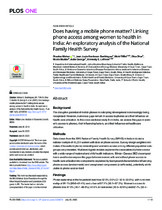Does having a mobile phone matter? Linking phone access among women to health in India: An exploratory analysis of the National Family Health Survey

View/
Date
2020Author
George, Asha
Mohan, Diwakar
Bashingwa, Jean Juste Harrisson
Metadata
Show full item recordAbstract
The disruptive potential of mobile phones in catalyzing development is increasingly being recognized. However, numerous gaps remain in access to phones and their influence on health care utilization. In this cross-sectional study from India, we assess the gaps in women’s access to phones, their influencing factors, and their influence on health care utilization. Methods Data drawn from the 2015 National Family Health Survey (NFHS) in India included a national sample of 45,231 women with data on phone access. Survey design weighted estimates of household phone ownership and women’s access among different population subgroups are presented. Multilevel logistic models explored the association of phone access with a wide range of maternal and child health indicators. Blinder-Oaxaca (BO) decomposition is used to decompose the gaps between women with and without phone access in health care utilization into components explained by background characteristics influencing phone access (endowments) and unexplained components (coefficients), potentially attributable to phone access itself. Findings Phone ownership at the household level was 92.8% (95% CI: 92.6–930%), with rural ownership at 91.1% (90.8–91.4%) and urban at 97.1% (96.7–97.3%).
